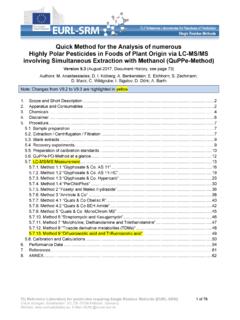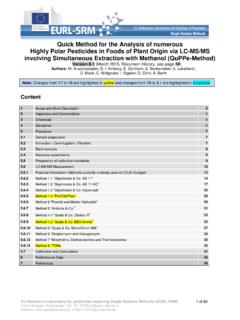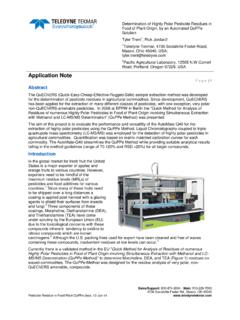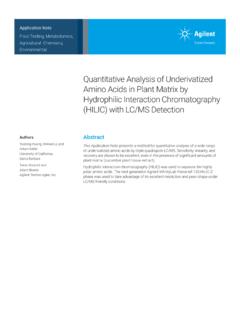Transcription of Quick Method for the LC-MS/MS Analysis of …
1 Quick Method for the LC-MS/MS Analysis of highly Polar Pesticides in Foods of Plant Origin involving a Common Extraction Step with methanol Para m s informaci n sobre las columnas OBELISC y Est ndares Certificados Dr. Ehrenstorfer contacte con: CROMLAB Acer 30, 32 08034 Barcelona Tel. 93 223 33 19 E-mail: !"! # $ % &' ( ) * ( 1 of 16 Community Reference Laboratories for Residues of PesticidesSingle Residue methods Quick Method for the LC-MS/MS Analysis of highly Polar Pesticides in Foods of Plant Origin involving a Common Extraction Step with methanol 1. Scope and Short Description A Method is described for the Analysis of polar, non-QuEChERS-amenable pesticides (log Kow < -2) in foods of plant origin such as fruits (including dried fruits), vegetables, cereals and processed prod-ucts thereof. Residues are extracted from the test portion following the addition of acidified methanol . The mixture is centrifuged, filtered and directly analyzed by LC-MS/MS .)
2 Quantification is performed with the help of isotopically labeled internal standards (analogues of the target analytes), which are added directly to the test portion at the beginning of the procedure. 2. Apparatus and Consumables Powerful sample processing equipment, for example Stephan UM 5 50 ml centrifuge tubes with screw caps, for example: a) 50 ml Teflon centrifuge tubes with screw caps ( Nalgene/Rochester, USA; Oak-ridge, article-no. 3114-0050) or b) disposable 50 ml centrifuge tubes ( Sarstedt/N mbrecht, Germany, 114x28 mm, PP, article-no. ) ml. 10 ml solvent-dispenser for methanol Centrifuge, suitable for the centrifuge tubes employed in the procedure and capable of achiev-ing at least 2000 g Syringes, 2 or 5 mL disposable syringes Syringe filters, m pore size Injection vials, suitable for LC auto-sampler !"! # $ % &' ( ) * ( 2 of 16 Community Reference Laboratories for Residues of PesticidesSingle Residue methods 3. Chemicals Unless otherwise specified, use reagents of recognized analytical grade.
3 Take every precaution to avoid possible contamination of water, solvents, sorbents, inorganic salts, etc. methanol , HPLC quality Acetonitrile, HPLC quality Concentrated formic acid (> 95%) Citric acid monohydrate Dimethylamine ( 40%, Fluka article-no. 38940) Ammonium formate Water (deionized) Pesticides or pesticide stock solutions Isotopically labeled standards (see Annex) 4. Disclaimer This Method refers to several trade name products and instruments which are commercially available and suitable for the described procedure. This information is given for the convenience of the users of this Method and does not constitute an endorsement by the CRL of the products named. The application of this Method may involve hazardous materials, operations and equipment. It is the responsibility of the users of this Method to establish appropriate safety and health practices prior to use. 5. Procedure Sample preparation To obtain representative test-portions from the laboratory sample, proceed as required by the respec-tive regulations and guidelines.
4 For fruits and vegetables cryogenic milling ( using dry ice) is to be preferred. In the case of dried fruits and similar commodities (< 30 % water content) the following procedure is proposed: Add 850 g of cold water to 500 g frozen dried fruits and homogenize the mixture (if possible by adding dry ice). g of this homogenate will correspond to 5 g sample. !"! # $ % &' ( ) * ( 3 of 16 Community Reference Laboratories for Residues of PesticidesSingle Residue methods Extraction Weigh 10 g* of the comminuted sample into a 50 mL centrifuge tube. *Note: When analyzing dry samples such as grains, raisins or flour, the sample amount should be re-duced to 5 g. Smaller test samples may be required for extract-rich commodities or commodities with high water absorbing capacity not allowing proper extraction. The amount of water to be added to the different dry commodities is shown in Table 9 in the Annex. Add 100 L of isotopically labeled internal standard solution of the analyte(s) Table 1: Exemplary concentrations of the isotopically labeled ISTDs: Analyte ISTD S ggested Concentra-tion of ISTD solution in g/mL Expected concen-tration of ISTD in final extract in g/mL Chlormequat Chlormequat chloride D4 10-20 Mepiquat Mepiquat iodide D3 10-20 Ethephon Ethephon D4 10-20 Fosetyl-Al Fosetyl-Al D15 10-20 Maleic acid hydrazide Maleic acid hydrazide D2 20-200* 1-10 Daminozide Daminozide D6 10-20 Glyphosate Glyphosate 13C2 15N 10-20 AMPA AMPA 13C 15N 10-20 * Keep in mind that the ISTD may contain some amounts of non-labelled maleic hydrazide.)
5 Smaller amounts of ISTD added will reduce the added amount of maleic hydrazid to the sample. Having approximately the same concentration of ISTD in sample extract and calibration solutions is paramount. Add 10 mL acidified methanol ( methanol containing 1% concentrated formic acid). Close the tube and shake vigorously for 1 to 2 min. The resulting volume of the extract (taking into account the natural water content of the sample and the miscibility of water and methanol ) is ca. 20 mL (corresponding to g sample per mL extract). Centrifuge ( 5 min at >2500 g) Transfer an aliquot of the extract into a syringe and filter it into an autosampler vial. Employ for LC-MS/MS Analysis !"! # $ % &' ( ) * ( 4 of 16 Community Reference Laboratories for Residues of PesticidesSingle Residue methods Recovery experiments and preparation of blank extracts Sample preparation for recovery experiments: Spike 100 L (use small volumes!) of a pesticide standard solution to the blank-matrix portion* and proceed sample preparation as described for the test sample.)
6 *Use the same sample amount as for the test sample! Preparation of blank extract for matrix matched calibrations: Take 10 g* of blank matrix test portion* (not containing any detectable residues of the analyte) and proceed sample preparation exactly the same way as described for the test sample. However, DO NOT ADD ISTD. Transfer suffi-cient aliquots of the blank extract to HPLC autosampler vials and proceed according to *Use the same sample amount as for the test sample! Preparation of Calibration Standards An exemplary pipetting scheme for the preparation of a calibration solution is shown in Table 2. Note: Where isotopically labeled ISTDs are used matrix-matched calibration is not essential as the ISTD matches for any matrix-related signal suppressions or enhancements. Where isotopically labeled ISTDs are not used matrix matching is essential. Table 2: Pipetting scheme for the preparation of a calibration solution (exemplary) Matrix-matched using ISTD without ISTD Solvent based Blank extract or methanol with 1% formic acid 800 L 900 L 800 L ISTD solution (diluted): 1:20 dilution of the solution added to the test sample in step 100 L* - 100 L* Pesticide standard solution g/mL** 100 L 100 L 100 L Total volume 1000 L 1000 L 1000 L * Same volume as added in ** In this case the end-concentration of the pesticide in the calibration standard equals g/mL, which is equivalent to mg/kg (when using 10 g test portions) or mg/kg (when using 5 g test portions).
7 It is of high importance to prepare the calibration solutions in a way that the ISTD-concentration approximately equals that of the final extracts of the test samples. !"! # $ % &' ( ) * ( 5 of 16 Community Reference Laboratories for Residues of PesticidesSingle Residue methods LC-MS/MS Measurement Conditions Any suitable LC and MS/MS conditions may be used. Below you will find some proposals of instrument parameters. Table 3: Proposed LC-MS/MS conditions for Ethephon, Glyphosat, AMPA* (metabolite of Glyphosate), Glufosinate, MPPA* (metabolite of Glufosinate) Instrument parameters Conditions Ionization mode ESI neg Column** Dionex IonPac AS 11 2 x 250 mm (P/N 44077) Pre-column Dionex IonPac AG11 2 x 50 mm (P/N 44079) Eluent A Water Eluent B Make sure your solvent filters of the eluent can handle alkaline solvents. 1 mM citric acid in water adjusted to pH 11 with di-methylamine Gradient Flow: mL/min Gradient: 100% A in 8 min to 50 or 100 % B hold B for about 7 min Injection volume 20 L (in case of analyzing only ethephon 5 L may be eno gh -depending on the instrument) Calibration solutions and levels or g/ISTD + one level near the LOD is recommended Aquired mass transitions AMPA 110/63 (target ion) AMPA 110/79 AMPA 110/81 Ethephon 143/107 (target ion) Ethephon 143/79 Ethephon 145/107 Glufosinate 180/136 Glufosinate 180/63 (target ion) Glufosinate 180/85 Glufosinate 180/95 Glyphosate 168/124 Glyphosate 168/150 Glyphosate 168/63 (target ion) Glyphosate 168/81 MPPA 151/63 (target ion) MPPA 151/107 MPPA 151/133 AMPA 13C15N 112/63 (internal standard) Ethephon D4 147/111 (internal standard) Glyphosate 13C215N 171/63 (internal standard) X AMPA: Aminomethylphosphonic acid; MPPA: 3-Methylphosphinicopropionic acid !)
8 "! # $ % &' ( ) * ( 6 of 16 Community Reference Laboratories for Residues of PesticidesSingle Residue methods **Column Care: To extend the lifetime of the column, it is recommended to change the guard column regularly. Additionally, the column should be flushed from time to time with 30 mM NaOH for cleaning. If many samples are analyzed per sequence, this cleaning procedure may be necessary after every sequence to extend the life-time of the column. The NaOH solution has to go directly into a waste bottle and MUST NOT reach the ion source of the MS!! Especially for AMPA, MPPA and glufosinate it is important to have a column with a good performance. Otherwise peak shapes worsen considerably and substantial retention time shifts occur depending on the matrix. Figure 1: Typical chromatograms of Glyphosate, AMPA, Glufosinate, MPPA and Ethephon CRL-SRMC ommunity Reference Laboratoryfor Pesticide ResiduesusingSingle Residue methods SRM% + ,#- # . ,," # % ,-" # .. ,/" # Spargel mit ug/IS bw.)
9 ML in MeOH+1%AS - Glyphosat / (Unknown) amu - sample 25 of 34 from Area: +004 counts Height: +003 cps RT: min1234567891011 Time, min0200400600800100012001400160018002000 2200240026002800300032003400I n t e n s i t y , c p sSpargel mit ug/IS bw. mL in MeOH+1%AS - AMPA / (Unknown) amu - sample 25 of 34 from Validierung Area: +004 counts Height: +003 cps RT: min1234567891011 Time, min0200400600800100012001400160018002000 22002400260028003000320034003600I n te n s it y , c p Spargel mit ug/IS bw. mL in MeOH+1%AS - Glufosinate / (Unknown) amu - sample 25 of 34 from Area: +004 counts Height: +003 cps RT: min1234567891011 Time, min0500100015002000250030003500400045005 000550060006500I n te n s i t y , c p sSpargel mit ug/IS bw. mL in MeOH+1%AS - MPPA / (Unknown) amu - sample 25 of 34 from Validierung Area: +005 counts Height: +004 cps RT: min1234567891011 Time, n te n s i ty , c p sSpargel mit ug/IS bw. mL in MeOH+1%AS - Ethephon / (Unknown) amu - sample 25 of 35 from Area: +004 counts Height: +003 cps RT: min1234567891011 Time, min0500100015002000250030003500400045005 000550060006500I n t e n s i t y , c p sKartoffel mit ug/IS bw.
10 ML in MeOH+1%AS - Glyphosat / (Unknown) amu - sample 27 of 34 from Area: +004 counts Height: +003 cps RT: min1234567891011 Time, min0200400600800100012001400160018002000 220024002600280030003200I n t e n s it y , c p s Kartoffel mit ug/IS bw. mL in MeOH+1%AS - AMPA / (Unknown) amu - sample 27 of 34 from Validierung Area: +004 counts Height: +003 cps RT: min1234567891011 Time, min0500100015002000250030003500400045005 0005500I n te n s i t y , c p Kartoffel mit ug/IS bw. mL in MeOH+1%AS - Glufosinate / (Unknown) amu - sample 27 of 34 from Area: +004 counts Height: +003 cps RT: min1234567891011 Time, min0500100015002000250030003500400045005 0005500600065007000I n t e n s i ty , c p s Kartoffel mit ug/IS bw. mL in MeOH+1%AS - MPPA / (Unknown) amu - sample 27 of 34 from Validierung Area: +005 counts Height: +004 cps RT: min1234567891011 Time, n t e n s i t y , c p mit ug/IS bw. mL in MeOH+1%AS - Ethephon / (Unknown) amu - sample 27 of 35 from Area: +004 counts Height: +003 cps RT: min1234567891011 Time, min0500100015002000250030003500400045005 0005500600065007000I n t e n s i t y , c p sErdbeere mit ug/IS bw.





